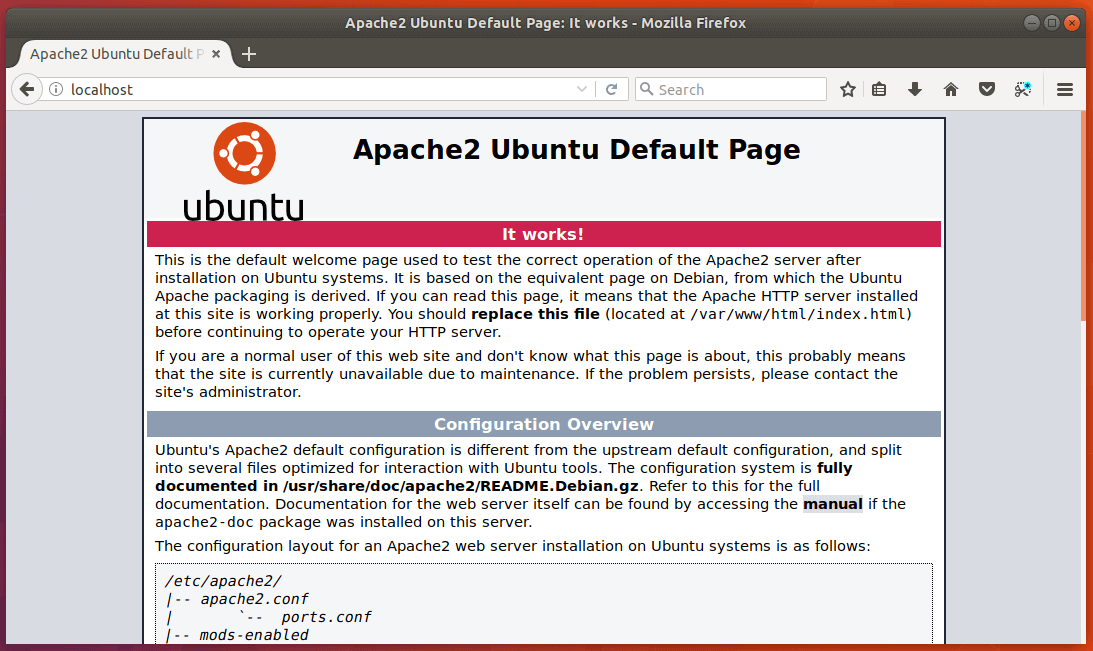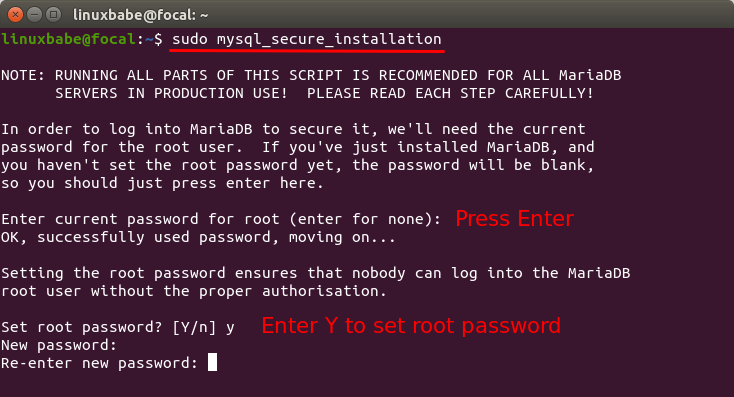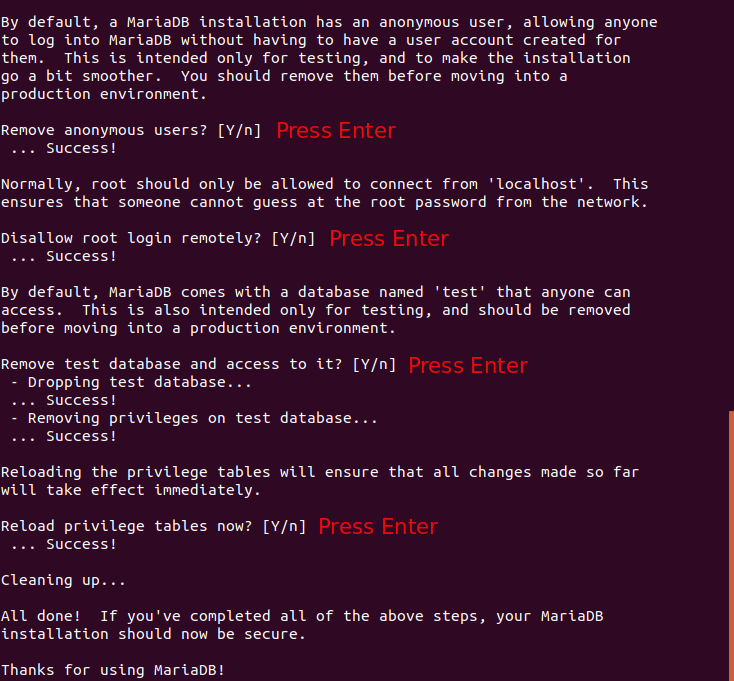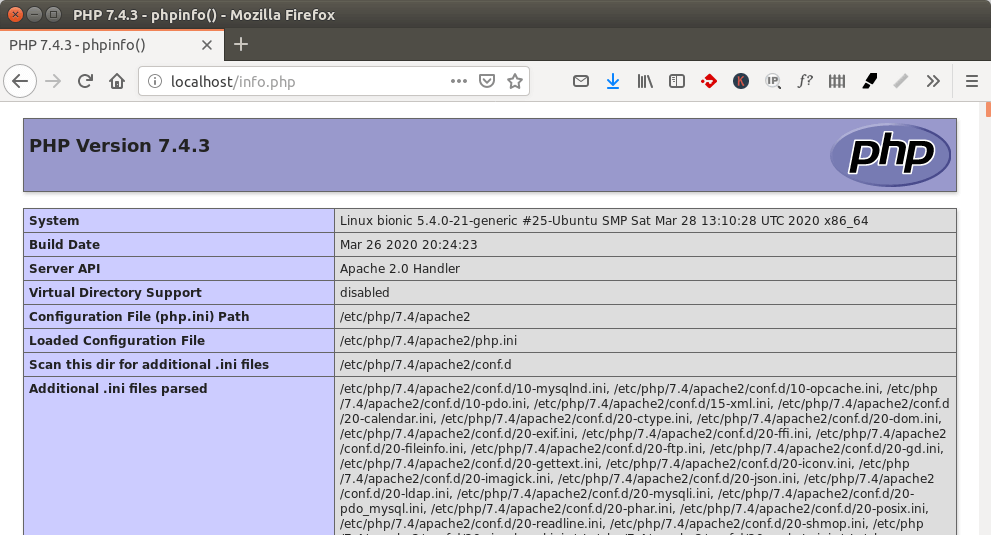How to Install LAMP Stack on Ubuntu 20.04 Server/Desktop
This tutorial is going to show you how to install LAMP stack on Ubuntu 20.04 LTS. A software stack is a set of software tools bundled together. LAMP stands for Linux, Apache, MariaDB/MySQL, and PHP, all of which are open source and free to use. It is the most common software stack that powers dynamic websites and web applications. Linux is the operating system; Apache is the web server; MariaDB/MySQL is the database server and PHP is the server-side scripting language responsible for generating dynamic web pages.
Requirements
To follow this tutorial, you need an Ubuntu 20.04 OS running on your local computer or on a remote server.
If you are looking for a virtual private server (VPS), I recommend Kamatera VPS, which features:
- 30 days free trial.
- Starts at $4/month (1GB RAM)
- High-performance KVM-based VPS
- 9 data centers around the world, including the United States, Canada, UK, Germany, The Netherlands, Hong Kong, and Isreal.
Follow the tutorial linked below to create your Linux VPS server at Kamatera.
Once you have a VPS running Ubuntu 20.04, follow the instructions below.
And if you need to set up LAMP stack with a domain name, I recommend buying domain names from NameCheap because the price is low and they give whois privacy protection free for life.
Step 1: Update Software Packages
Before we install the LAMP stack, it’s a good idea to update the repository and software packages. Run the following commands on your Ubuntu 20.04 OS.
sudo apt update sudo apt upgrade
Step 2: Install Apache Web Server
Enter the following command to install Apache Web server. The apache2-utils package will install some useful utilities like Apache HTTP server benchmarking tool (ab).
sudo apt install -y apache2 apache2-utils
After it’s installed, Apache should be automatically started. Check its status with systemctl.
systemctl status apache2
Sample output:
● apache2.service - The Apache HTTP Server Loaded: loaded (/lib/systemd/system/apache2.service; enabled; vendor preset: enabled) Active: active (running) since Sat 2020-04-11 11:31:31 CST; 2s ago Docs: https://httpd.apache.org/docs/2.4/ Process: 53003 ExecStart=/usr/sbin/apachectl start (code=exited, status=0/SUCCESS) Main PID: 53011 (apache2) Tasks: 55 (limit: 19072) Memory: 6.4M CGroup: /system.slice/apache2.service ├─53011 /usr/sbin/apache2 -k start ├─53012 /usr/sbin/apache2 -k start └─53013 /usr/sbin/apache2 -k start
Hint: If the above command doesn’t quit immediately, you can press Q key to gain back control of the terminal.
If it’s not running, use systemctl to start it.
sudo systemctl start apache2
It’s also a good idea to enable Apache to automatically start at system boot time.
sudo systemctl enable apache2
Check Apache version:
apache2 -v
Output:
Server version: Apache/2.4.41 (Ubuntu) Server built: 2020-03-05T18:51:00
Now type in the public IP address of your Ubuntu 20.04 server in the browser address bar. You should see the “It works!” Web page, which means Apache Web server is running properly. If you are installing LAMP on your local Ubuntu 20.04 computer, then type 127.0.0.1 or localhost in the browser address bar.

If the connection is refused or failed to complete, there might be a firewall preventing incoming requests to TCP port 80. If you are using iptables firewall, then you need to run the following command to open TCP port 80.
sudo iptables -I INPUT -p tcp --dport 80 -j ACCEPT
If you are using the UFW firewall, then run this command to open TCP port 80.
sudo ufw allow http
Now we need to set www-data (Apache user) as the owner of document root (otherwise known as web root). By default it’s owned by the root user.
sudo chown www-data:www-data /var/www/html/ -R
By default, Apache uses the system hostname as its global ServerName. If the system hostname can’t be resolved in DNS, then you will probably see the following error after running sudo apache2ctl -t command.
AH00558: apache2: Could not reliably determine the server's fully qualified domain name, using 127.0.0.1. Set the 'ServerName' directive globally to suppress this message
To solve this problem, we can set a global ServerName in Apache. Use the Nano command-line text editor to create a new configuration file.
sudo nano /etc/apache2/conf-available/servername.conf
Add the following line in this file.
ServerName localhost
Save and close the file. To save a file in Nano text editor, press Ctrl+O, then press Enter to confirm. To exit, press Ctrl+X. Then enable this config file.
sudo a2enconf servername.conf
Reload Apache for the change to take effect.
sudo systemctl reload apache2
Now if you run the sudo apache2ctl -t command again, you won’t see the above error message.
Step 3: Install MariaDB Database Server
MariaDB is a drop-in replacement for MySQL. It is developed by former members of MySQL team who are concerned that Oracle might turn MySQL into a closed-source product. Enter the following command to install MariaDB on Ubuntu 20.04.
sudo apt install mariadb-server mariadb-client
After it’s installed, MariaDB server should be automatically started. Use systemctl to check its status.
systemctl status mariadb
Output:
● mariadb.service - MariaDB 10.3.22 database server Loaded: loaded (/lib/systemd/system/mariadb.service; enabled; vendor preset: enabled) Active: active (running) since Fri 2020-04-10 14:19:16 UTC; 18s ago Docs: man:mysqld(8) https://mariadb.com/kb/en/library/systemd/ Main PID: 9161 (mysqld) Status: "Taking your SQL requests now..." Tasks: 31 (limit: 9451) Memory: 64.7M CGroup: /system.slice/mariadb.service └─9161 /usr/sbin/mysqld
If it’s not running, start it with this command:
sudo systemctl start mariadb
To enable MariaDB to automatically start at boot time, run
sudo systemctl enable mariadb
Now run the post-installation security script.
sudo mysql_secure_installation
When it asks you to enter MariaDB root password, press Enter key as the root password isn’t set yet. Then enter y to set the root password for MariaDB server.

Next, you can press Enter to answer all remaining questions, which will remove anonymous user, disable remote root login and remove test database. This step is a basic requirement for MariaDB database security. (Notice that Y is capitalized, which means it is the default answer. )

By default, the MariaDB package on Ubuntu uses unix_socket to authenticate user login, which basically means you can use username and password of the OS to log into MariaDB console. So you can run the following command to login without providing MariaDB root password.
sudo mariadb -u root
To exit, run
exit;
Check MariaDB server version information.
mariadb --version
As you can see, we have installed MariaDB 10.3.22.
mariadb Ver 15.1 Distrib 10.3.22-MariaDB, for debian-linux-gnu (x86_64) using readline 5.2
Step 4: Install PHP7.4
At the time of this writing, PHP7.4 is the latest stable version of PHP and has a minor performance edge over PHP7.3. Enter the following command to install PHP7.4 and some common PHP modules.
sudo apt install php7.4 libapache2-mod-php7.4 php7.4-mysql php-common php7.4-cli php7.4-common php7.4-json php7.4-opcache php7.4-readline
Enable the Apache php7.4 module then restart Apache Web server.
sudo a2enmod php7.4 sudo systemctl restart apache2
Check PHP version information.
php --version
Output:
PHP 7.4.3 (cli) (built: Mar 26 2020 20:24:23) ( NTS )
Copyright (c) The PHP Group
Zend Engine v3.4.0, Copyright (c) Zend Technologies
with Zend OPcache v7.4.3, Copyright (c), by Zend Technologies
To test PHP scripts with Apache server, we need to create a info.php file in the document root directory.
sudo nano /var/www/html/info.php
Paste the following PHP code into the file.
<?php phpinfo(); ?>
To save a file in Nano text editor, press Ctrl+O, then press Enter to confirm. To exit, press Ctrl+X. Now in the browser address bar, enter server-ip-address/info.php. Replace server-ip-address with your actual IP. If you follow this tutorial on your local computer, then type 127.0.0.1/info.php or localhost/info.php.
You should see your server’s PHP information. This means PHP scripts can run properly with Apache web server.

How to Run PHP-FPM with Apache
There are basically two ways to run PHP code with Apache web server:
- Apache PHP module
- PHP-FPM.
In the above steps, the Apache PHP7.4 module is used to handle PHP code, which is usually fine. But in some cases, you need to run PHP code with PHP-FPM instead. Here’s how.
Disable the Apache PHP7.4 module.
sudo a2dismod php7.4
Install PHP-FPM.
sudo apt install php7.4-fpm
Enable proxy_fcgi and setenvif module.
sudo a2enmod proxy_fcgi setenvif
Enable the /etc/apache2/conf-available/php7.4-fpm.conf configuration file.
sudo a2enconf php7.4-fpm
Restart Apache for the changes to take effect.
sudo systemctl restart apache2
Now if you refresh the info.php page in your browser, you will find that Server API is changed from Apache 2.0 Handler to FPM/FastCGI, which means Apache web server will pass PHP requests to PHP-FPM.

Congrats! You have successfully installed LAMP stack (Apache, MariaDB and PHP7.4) on Ubuntu 20.04. For your server’s security, you should delete info.php file now to prevent prying eyes.
sudo rm /var/www/html/info.php
Next Step
I hope this tutorial helped you install LAMP stack on Ubuntu 20.04 LTS. You may want to install phpMyAdmin, which is a free and open-source web-based database management tool.
You can also install WordPress on top of the LAMP stack to create your own website or blog.
As always, if you found this post useful, then subscribe to our free newsletter to get more tips and tricks. Take care 🙂



Good!
Xiao, your content is head and shoulders above every resource I’ve encountered…I can’t thank you, enough, for your efforts.
The tutorial “How to Install LAMP Stack on Ubuntu 20.04 Server/Desktop” was very useful. I was sble to install the LAMP stack without any problems. This is a prelude to installing OpenDocMan which is the next step to be performed. Would you happen to have a tutorial for doing this?
Thank you very much for your turorial. I plan to make a small donation to you.
Thank you very much. Very helpful and successful for me…..(Y)
can you do the same for MEAN stack?
Great tutorial, works every time. Could do with a section on changing the apache config to put index.PHP before index.html.
Cheers,
Thanks for the tutorial, i was able to install and the FPM was a interesant option i,m going to use it. thanks a lot
Hey there thanks for the wonderful tutorial such a great tech write-up. Question for ya hope you can help do I just built my server and it’s showing fingerprint key information for SSH on boot up with cloud-init in the terminal like it’s trying to connect why is this happening and what is it trying to connect to ? I would like to disable it if it’s not necessary for a lamp server and to have remote access via ssh? Thanks for your help.
Thanks, this was very helpful!
Great instructions! Everything installed without a hitch. Thank you!
Thank you very much.. Very helpful tutorial!!!
Good stuff! Installation on AWS EC2 went without a hitch.
GREAT! Running on GCP with no worries at all! KUDOS!
Hi,
Very good tutorial.
Do you have also done something about security of the LAMP Server (Fail2ban, ect…) ?
Best regards,
Best tutorial congrats and thank you
Whoop after many install attempts and wrong advice finally a site that puts it in easy to follow instructions, installed without any hassle. might just donate some cash as i was on the threshold of giving ubuntu up and revert to ‘you know who’ operating system lol Very good advice on here, can’t go wrong 😉
Thanks for the donation 🙂
Hi,
Very good tutorial.
Is there a mysql installation guide instead of MariaDB?
Hi, well it seems I’ve broke something
Maria DB doesn’t start
$ systemctl status mariadb
$ sudo systemctl start mariadb
$ journalctl -xe
Check MariaDB error log
/var/log/mysql/error.log.Hi Xiao, I’ve finally reinstalled my server, MariaDB was confliction with a previous MySQL install and I was unable to clear properly the error.
Great tutorial.
Thanks!
There is an easier way to do most of this: install tasksel.
sudo apt install tasksel
sudo tasksel
Select “LAMP server” and click OK.
A great tutorial. I wish others were as clear and comprehensive as this.
Thanks for the tutorial, you save my life 😀
This is fantastic. This tutorial made setting up my LAMP stack very easy. Thanks so much for taking the time to write this.
I get this error: “Module php7.4-fpm does not exist” when I try: sudo a2enmod php7.4-fpm. Up to this everything runs without errors.
Any suggestion?
Enable the Apache PHP module.
Disable the Apache PHP module.
Enable PHP-FPM for Apache
Disable PHP-FPM for Apache.
Super…. thanks
Very good and straightforward tutorial. Thanks. Saves a lot of time.
PHP-fpm
OS: Ubuntu 20.10 groovy
You must run:
systemctl restart php7.4-fpm.service
How can you use systemctl on wsl2 when it is not supported?
If you use Windows Subsystem for Linux (WSL), you need to use the traditional
servicecommand like so:Apache
MariaDB
PHP-FPM
Thanks for the info and have set up to receive your “Linux Tutorials”.
Also sent you email on that donation method you have up.
Hello Mike, thanks for your donation 🙂
Hi,
I am new to Linux and ubuntu server. I follow our tutorial, which is great. But I was never able to access 127.0.0.1, neither local host. I can only access the php page (to confirm it is working) and apache2 page, using my lan server address 192.168.xx.xx.
So what I am doing wrong? Is there any report/log that I can generate to make sure I follow all the steps?
Regards,
Gustavo
Hello .
I went through all the steps but to check
php.info
This shows the web page.
Not Found
The requested URL was not found on this server.
Apache / 2.4.41 (Ubuntu) Server at aa.aa.aa.aa Port 80
Boss! Elegant! Just the right information level, and well presented.
Great tutorial. Please could you update when Ubuntu Server 22.04 is released?
Do you have a tutorial coming soon to support new Ubuntu server 22.04 LTS ? Also what about PHP should we still be using 7.4 for Nextcloud as this link shows that Nextcloud is supporting newer PHP https://docs.nextcloud.com/server/latest/admin_manual/installation/system_requirements.html
Could you update tutorial for these items as I tried to change the commands from php7.4 to 8.0 or 8.1 and it gives errors?
Do you have tutorial on scripting this or would it be something you would put together? Hyper-V building out the VM machine deploying Ubuntu and LAMP with NextCloud? Just an idea I know its alot of work.
You need to upgrade Nextcloud to the latest version before you can use PHP8.1.
2 Ways to Upgrade Nextcloud [Command-Line & GUI]
Then learn how to install and use multiple versions of PHP on Ubuntu server.
Great tutorial. VERY USEFUL. thanks…
I copy/pasted each command into my bash window on the latest Peppermint Linux 11 (based on Debian), and it worked like a charm. Many thanks for such very clear instructions. I had always used tasksel on Ubuntu, but that was not available in Peppermint.
I am using this on a stand-alone PC for development purposes, and for security, do not want apache to respond to requests from outside of the localhost, so I added the following refinement to /etc/apache2/ports.conf
Listen 127.0.0.1:80